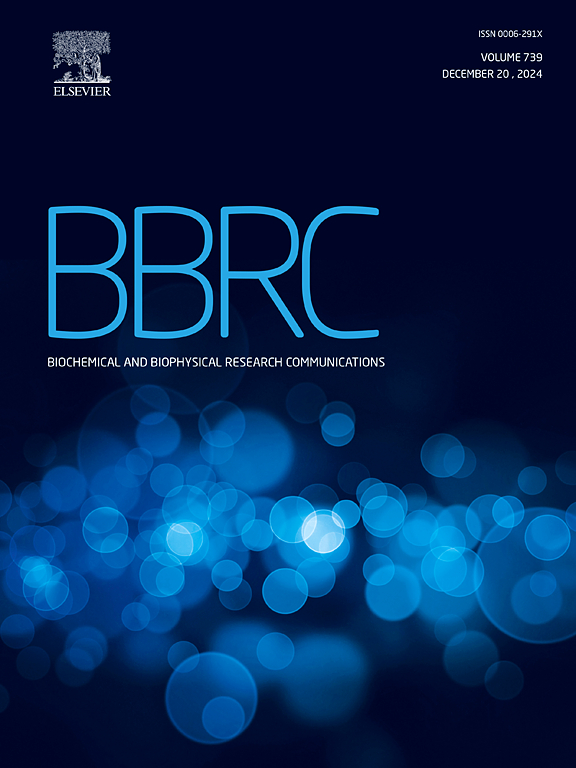Neuroprotective effect of Thymus vulgaris on paraquat induced Parkinson's disease
IF 2.5
3区 生物学
Q3 BIOCHEMISTRY & MOLECULAR BIOLOGY
Biochemical and biophysical research communications
Pub Date : 2025-04-02
DOI:10.1016/j.bbrc.2025.151740
引用次数: 0
Abstract
The dramatic surge of neurodegenerative disorders among elderly population underscore the pressing demand for development of optimal and evidence based noninvasive natural treatment strategies. Paraquat exposure in animal models used in scientific studies can cause a variety of clinical signs of Parkinson disease (PD). The health benefits of thyme include antioxidant, anti-inflammatory, pulmonary, and neurological benefits. Thyme and other herbal treatments are frequently used to treat a variety of conditions, including neurological issues. The primary factor in the etiology of neurodegeneration is oxidative stress. Conventional treatments are indicated to potentially have negative side effects. The primary phytochemicals of Thymus vulgaris (TV), which are responsible for its unique therapeutic property of neuro-protection, include hydrocarbon and phenolic compounds like thymol and carvacrol. The goal of the current investigation was to examine T. vulgaris' potential for neuroprotection while also ensuring its safety. Analyses of the plant's physicochemical and phytochemical composition were performed by liquid chromatographic analysis. Neuro-behavioral and biochemical parameters were evaluated to determine the impact of T. vulgaris in paraquat induced parkinsonian rodents model. The neurobehavioral tests include open field tests for movement and exploration, Y maze test and elevated plus maze test for natural behavior, memory, and anxiety, hole board tests for exploratory behavior, ladder climbing, foot printing, and wire hanging tests for estimating neuromuscular coordination. T. vulgaris treatment significantly improved neurobehavioral parameters dose-dependently, Biochemical analysis revealed that extract treatment mitigated the declined level of antioxidant enzymes. RT-PCR analysis showed that in paraquat treated group mRNA expression of IL-1α, IL-1β, Alpha-Synuclein, TNF-α, and IL-6 was upregulated markedly. However, T. vulgaris treatment dose dependently down-regulated the mRNA expression of these genes. The groundbreaking results of current study revealed that T. vulgaris restored the degenerative alterations, neuro-inflammation, and nerve loss in the brain structure, as evident by histopathological investigation. Particularly remarkable restoration in neuropsychological and biochemical markers emphasize the medicinal potential of T. vulgaris as a revolutionary treatment for neurodegenerative disorders, offering new hope for millions worldwide afflicted by these devastating conditions.
百里香对百草枯诱发的帕金森病的神经保护作用
老年人群中神经退行性疾病的急剧增加强调了开发最佳和基于证据的无创自然治疗策略的迫切需求。在科学研究中使用的动物模型中暴露百草枯可引起帕金森病(PD)的各种临床症状。百里香对健康的好处包括抗氧化、抗炎、肺和神经系统的好处。百里香和其他草药疗法经常用于治疗各种疾病,包括神经问题。神经退行性疾病的主要病因是氧化应激。传统的治疗方法有潜在的副作用。百里香(thyymus vulgaris, TV)的主要植物化学物质包括碳氢化合物和酚类化合物,如百里香酚和香芹酚,具有独特的神经保护作用。目前研究的目的是在确保其安全性的同时,检查寻常绦虫对神经保护的潜力。采用液相色谱法对该植物的理化成分和化学成分进行分析。采用神经行为学和生化指标评价寻常夜蛾对百草枯致帕金森鼠模型的影响。神经行为测试包括运动和探索的野外测试,自然行为、记忆和焦虑的Y迷宫测试和高架迷宫测试,探索行为的孔板测试,爬梯子的测试,脚印的测试,以及估计神经肌肉协调的挂线测试。黄芪提取物对大鼠神经行为参数的改善呈剂量依赖性,生化分析显示,黄芪提取物对大鼠抗氧化酶水平下降有缓解作用。RT-PCR分析显示,百草枯处理组IL-1α、IL-1β、α -突触核蛋白、TNF-α、IL-6 mRNA表达明显上调。然而,赤霉病处理剂量依赖性地下调了这些基因的mRNA表达。本研究的突破性结果表明,寻常绦虫可以恢复大脑结构的退行性改变、神经炎症和神经丧失,这一点在组织病理学研究中得到了证实。神经心理学和生物化学标志物的显著恢复强调了寻常绦虫作为神经退行性疾病的革命性治疗方法的药用潜力,为全世界数百万遭受这些毁灭性疾病折磨的人带来了新的希望。
本文章由计算机程序翻译,如有差异,请以英文原文为准。
求助全文
约1分钟内获得全文
求助全文
来源期刊
CiteScore
6.10
自引率
0.00%
发文量
1400
审稿时长
14 days
期刊介绍:
Biochemical and Biophysical Research Communications is the premier international journal devoted to the very rapid dissemination of timely and significant experimental results in diverse fields of biological research. The development of the "Breakthroughs and Views" section brings the minireview format to the journal, and issues often contain collections of special interest manuscripts. BBRC is published weekly (52 issues/year).Research Areas now include: Biochemistry; biophysics; cell biology; developmental biology; immunology
; molecular biology; neurobiology; plant biology and proteomics

 求助内容:
求助内容: 应助结果提醒方式:
应助结果提醒方式:


